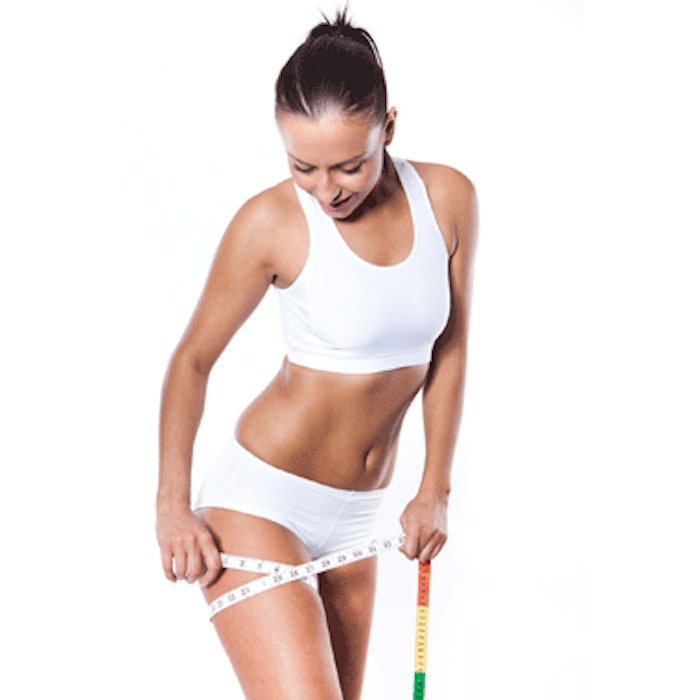
The idea that people can go to a doctor’s office, pay a fee, lie on a table and have fat removed from their bodies, without any type of surgical incision, once seemed the domain of science fiction novels and teenage dreams. Now, with the emergence of FDA-approved devices, such as CoolSculpting from Zeltiq (coolsculpting.com) and Liposonix from Solta Medical (liposonix.com), those dreams have become a reality in the eyes of the media and the general public. But questions remain: Do these noninvasive body contouring devices really deliver on the promise of nonsurgical weight loss? And which patients are buying?
Though noninvasive body contouring appeals to patients who desire a slimmer figure, it is not a substitute for liposuction. In May 2011, Clinics in Plastic Surgery published a review of radiofrequency (RF), Cryolipolysis and low-level laser-based devices, authored by R. Stephen Mulholland, MD, et al. The study found that the average noninvasive body contouring patient experienced a 2cm to 4cm reduction in circumference in the treated area. Additionally, the study noted that the best candidates for noninvasive body contouring were those patients who were determined not to have surgery and who would be happy with even small improvements.
“We market this as a minimally invasive, minimum downtime procedure, ideal for hard-to-treat areas such as muffin tops,” says Joseph Eviatar, MD, of Chelsea Eye and Cosmetic Surgery Associates in New York City. He uses Zeltiq CoolSculpting in his practice. “The ideal patient goes to the gym fairly regularly, eats a healthy diet and is close to his ideal weight, but he has stubborn fat deposits he’d like to get rid of.”
Fat Removal Options
Cryolipolysis and ultrasound are the only two technologies currently approved for permanent fat reduction as opposed to circumferential reduction. Cryolipolysis uses cold to destroy fat cells while leaving the surrounding tissue intact. It is employed in Zeltiq’s CoolSculpting, the first device to receive FDA approval for non-surgical fat reduction, and it offers practices an attractive business model. The device can be operated by non-medical professionals and does not require a technician in the room to deliver treatment. “The process is lengthy for the patient, but not for the provider,” says Dr. Eviatar. Typically, a patient has an initial consult, which may be with the doctor or with an aesthetic consultant. The technician attaches the handpiece to the problem area, and the patient relaxes while the machine does the work.
Image copyright iStockPhoto.com.
[pagebreak]
Ultrasound-based devices, such as Liposonix and the UltraShape Contour I System (pending FDA approval), do require an operator to deliver the treatment. This hands-on approach is a plus for some practitioners. Beverly Hills, California-based dermatologist David Amron, MD, chose the more operator-dependent Liposonix based on his expertise with liposuction and liposculpture. “I’m very specific about where I do liposuction on a patient, because it really is a re-proportioning procedure,” he says. “The same thing applies to the noninvasive procedures.” He prefers the ultrasound-based device because it allows the operator to blend the treatment area for a more natural look. “There is also a greater potential for thermal retraction with Liposonix, because it works thermally,” he says.
The heat of the Liposonix can cause discomfort to the patient during treatment. Dr. Amron gives patients Valium and Demerol prior to treatment and notes that the procedure is “uncomfortable but not unbearable. It’s less painful than Thermage tends to be on patients.”
Michael Gold, MD, dermatologist and director of the Gold Skin Care Center in Nashville, Tennessee, offers a variety of body contouring devices in his practice. “I reserve Cool Sculpting for flanks and I always tell my patients, If I can grab it, I can treat it,” he says. “That’s always the motto with CoolSculpting. I tell patients they’re going to lose about 25% of the fat with each treatment. When the device first came out, the company touted it as the one treatment to get rid of all your fat. The reality is, it’s not—you need several treatments most of the time.”
Even as marketing messages are tweaked and doctors finetune their treatment protocols, noninvasive body contouring is driving consumers into aesthetic practices. “I estimate that for every surgical body contouring procedure the practice does, we do three to four non-surgical procedures,” says Gregory Nikolaidis, MD, of Westlake Dermatology and Cosmetic Surgery in Austin, Texas. “Patients like the ease of use and the short recovery time.”
Dr. Eviatar has had a similar experience with CoolSculpting. “It’s one of the most sought-after procedures in our practice,” he says.
Circumferential Reduction
While the above technologies destroy fat cells outright, there are other noninvasive body shaping devices that reduce circumference by tightening skin in the area and shrinking the fat cells.
RF-based devices administer intense bursts of heat to tighten the skin. This therapy also reduces the size of fat cells and encourages lymphatic drainage and collagen formation. Patients usually have four to eight treatments lasting one half-hour on each area they wish to treat.
[pagebreak]
Devices in this category include the Viora Reaction (vioramed.com), Solta Medical’s Thermage (thermage.com), BTL Industries Exilis (btlaesthetics.com), Venus Freeze from Venus Concept (venus-concept.com), the EndyMed PRO from Eclipse Aesthetics (eclipseaesthetics.com), the Cutera truSculpt (cutera.com), Alma Lasers Accent XL (almalasers.com), the Apollo TriPollar RF from Lumiere Medical (lumieremed.com) and the Syneron VelaShape (velashape.com). “A lot of lasers and light sources work their way through our practice and we get to evaluate them,” says Dr. Gold. “Our go-to devices for skin tightening are the Alma Accent, the Apollo and the Venus Freeze. When we have people with cellulite, we mainly use the Velashape II device.”
Mary Lupo, MD, of the Lupo Center for Aesthetic and General Dermatology in New Orleans uses the BTL Exilis for noninvasive body contouring and starts patients with a series of four treatments. “I like that it gives me decent results I can give to the patient at a reasonable cost,” she says. “They see the impact after four treatments and they either opt to do a few more treatments in that area, or they move to another area. I’ve had patients doing treatments every two weeks for six months to a year.”
Side effects and complications from these noninvasive procedures are rare. Some patients report temporary bruising, numbness or a “pins and needles” feeling, all of which subside over time. Jeanine Downie of Image Dermatology in Montclair, New Jersey—who also offers the Exilis in her practice—has seen a few patients who are allergic to the adhesive on the grounding pads, as well as some who experienced panniculitis, which resolved on its own.
Fat deposits in the abdomen and flanks—including muffin tops, love handles or a post-pregnancy pooch—are the most common indications for these devices, but the doctors interviewed for this article also report successfully using their devices to reduce the size of male breasts and reduce or eliminate fat deposits around the bra line, chin and neck region, upper arms and inner thighs.
“What I’ve found over the years with these devices is you need to learn one or two of them really well, and then you position them where you think they work best,” says Dr. Gold. “I think the Accent works exceptionally well on thighs and abdomen. I like the Apollo for the neck and face. I also like the Pellevé (Ellman International, pelleve.com) for the face, especially around the eyes. We’re still learning the Exilis, but it seems to be best for big body parts, such as the abdomen and the thighs.”
[pagebreak]
Although multiple treatments are often required, Dr. Gold sells all of his noninvasive body contouring and skin tightening procedures per session. “I can sell a patient a package of six sessions, but what if she only needs two?” he says. “We’d rather charge as we go, because some patients see a quicker benefit than others.”
Is It Right for Your Practice?
When investigating equipment options, there are two issues at stake. The first is to determine whether these treatments are a good fit for your existing patient base. While noninvasive body contouring can be a profitable addition to many practices, it’s not for everyone. “If your practice is primarily medical or surgical, it probably doesn’t make sense for you to invest in this equipment,” says Dr. Nikolaidis. “The investment can be substantial—$80,000 to $100,000, plus the disposable costs.”
“It’s a great tool for an aesthetic practice,” agrees Dr. Eviatar. “If you have a general practice or a regular dermatological practice, there might not be enough demand in your patient population. Someone that buys the machine solely as a money-maker for a practice that doesn’t already have an aesthetic base would have to put a lot of effort into marketing and essentially transform the nature of the practice.”
Even existing aesthetic practices benefit from testing the waters prior to making a large investment. “I’d suggest doctors send a survey to their top 50 cosmetic patients and ask if this is something that interests them,” says Dr. Downie. She also suggests giving discounts to the first patients to build testimonials and encourage word-of-mouth marketing.
All of the doctors surveyed have information about noninvasive body contouring on their websites and keep brochures in the waiting room, but they all agree their best marketing tool is word-of-mouth referrals from other patients. “Patients send in their friends and relatives,” says Dr. Lupo.
[pagebreak]
The promise of a new and growing patient base for fat removal devices—such as CoolSculpting and Liposonix in particular—creates some concern for Dr. Amron who cautions physicians to remain vigilant in providing patient evaluations. “A lot of times people call because they hear a practice is offering this new device or they see a special. They go in. They are not evaluated by a physician, and then a staff member sells them a package,” he says. “It’s improper evaluation in terms of where to really target treatment. With these new technologies you can actually reduce the fat layer—and that’s a good thing—but you can actually shift the person’s storage of fat. If it’s being performed on someone who is 20 to 30 pounds overweight but completely in proportion, the patient’s body can be thrown out of proportion. Then you’ve done a disservice, and that’s my biggest concern in this whole arena.”
If the procedure is a good fit for your practice, the second step is choosing which device to purchase. In addition to the cost of the equipment, it’s important to look at the cost of consumables and staffing. Some systems require little staff time. Others require a hands-on operator to perform the treatment. You’ll also need space to provide the treatment, but this doesn’t have to be a dedicated room, since these devices are designed to be portable.
Dr. Gold urges physicians to ask companies for peer-
reviewed literature on their devices. “Although these are company-sponsored clinical trials, they need to be IRB-approved and peer-reviewed so at least we know there’s something there,” he says.
“You also have to consider your competition,” says Dr. Nikolaidis. “If every other clinic around you already has these machines, you may not be able to bring in enough business to make them profitable, as opposed to if you are in a metropolitan area where you’re the first to offer this.”
“If you’re already doing a lot of non-surgical cosmetic procedures such as Botox and other injectables, and lasers, then noninvasive body contouring could be a good fit,” says Dr. Nikolaidis.
Cindi Myers is a Colorado-based freelance writer who specializes in business and healthcare topics.











